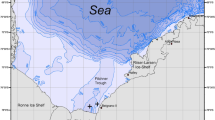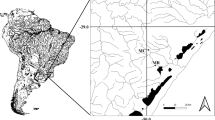Synopsis
Synopsis Pipefishes have rarely been watched in the wild and have never before been followed in their common seagrass habitats. This study explores the reproductive ecology of five species of pipefishes living in a Swedish eelgrass meadow during parts of four breeding seasons, tagging four of the species. Pipefish are remarkable for their specialised paternal care: only males aerate, osmoregulate and nourish the developing embryos. Two of the species (Entelurus aequoreus andNerophis ophidion) have simple ventral gluing of eggs on the trunk while three species (Syngnathus acus, S. rostellatus andS. typhle) have fully enclosed brood pouches on their tails. Males of the former species receive eggs from one female while males of the genusSyngnathus receive partial clutches from several females. Sex ratios of adults on the site differed from equal to male-biased to female-biased, according to species.S. typhle were most numerous and were resighted most often. They were present throughout the breeding season whereas there were temporal shifts in the presence of the other species on the meadow and in some sex ratios. Most species occurred in the deeper, denser part of the meadow but there was some habitat separation by species and sex. All species tended to stay low in the eelgrass, primarily coming up above the eelgrass to display and mate. No species showed site fidelity either to a home range or to the meadow, withE. aequoreus adults spending least time on the meadow. Sexual size dimorphism differed: males were larger inS. rostellatus, the same size inS acus and smaller in the other species. Although the species overlap in habitat requirements and breeding season, the only observed interspecific interactions were abortive courtships betweenSyngnathus species.
Similar content being viewed by others
References cited
Ahnesjö, I. 1995. Temperature affects male and female potential reproductive rates differently in the sex role-reversed pipefish,Syngnathus typhle. Behav. Ecol. 6: 229–233
Berglund, A. 1991. Egg competition in a sex-role reversed pipefish: subdominant females trade reproduction for growth. Evolution 45: 770–774
Berglund, A. & G. Rosenqvist. 1990. Male limitation of female reproductive success in a pipefish: effects of body-size differences. Behav. Ecol. Sociobiol. 27: 129–133
Berglund, A. & G. Rosenqvist. 1993. Selective males and ardent females in pipefishes. Behav. Ecol. Sociobiol. 32: 331–336
Berglund, A., G. Rosenqvist & I. Svensson. 1986a. Mate choice, fecundity and sexual dimorphism in two pipefish species (Syngnathidae). Behav. Ecol. Sociobiol. 19: 301–307
Berglund, A., G. Rosenqvist & I. Svensson. 1986b. Reversed sex roles and parental energy investment in zygotes of two pipefish (Syngnathidae) species. Mar. Ecol. Prog. Ser. 29: 209–215
Berglund, A., G. Rosenqvist & I. Svensson. 1988. Multiple matings and paternal brood care in the pipefish,Syngnathus typhle. Oikos 51: 184–188
Berglund, A., G. Rosenqvist & I. Svensson. 1989. Reproductive success of females limited by males in two pipefish species. Amer. Nat. 133: 506–516
Clutton-Brock, T.H. & A.C.J. Vincent. 1991. Sexual selection and the potential reproductive rates of males and females. Nature 351: 58–60
Fiedler, K. 1954. Vergleichende Verhaltenstudien an Seenadeln, Schlangennadeln und Seepferdchen (Syngnathidae). Z. Tierpsychol. 11: 358–416
Fries, B., C.U. Ekström & C. Sundevall. 1895. Lophobranchs. pp. 661–688.In: F.A. Smitt (ed.) A History of Scandinavian Fishes, 2nd edition, Marston & Co. Ltd., London
Gronell, A.M. 1984. Courtship, spawning and social organisation of the pipefish,Corythoichthys intestinalis (Pisces: Syngnathidae) with notes on two congeneric species. Z. Tierpsychol. 65: 1–24
Haresign, T.H. & S.E. Shumway. 1981. Permeability of the marsupium of the pipefishSyngnathus fuscus to [14C]-Alpha amino isobutyric acid. Comp. Biochem. Physiol. 69A: 603–604
Paulus, T 1993. Morphologie und Ökologie syntop lebender Syngnathidae (Pisces: Teleostei) des Roten Meeres. Ph.D. Thesis, Universität Mainz, Mainz. 160 pp
Quast, W.D. & N.R. Howe. 1980. The osmotic role of the brood pouch in the pipefishSyngnathus scovelli. Comp. Biochem. Physiol. 67A: 675–678
Roelke, D.L. & S.M. Sogard. 1993. Gender-based differences in habitat selection and activity level in the northern pipefish (Syngnathus fuscus). Copeia 1993: 528–532
Rosenqvist, G. 1990. Male mate choice and female-female competition for males in the pipefishNerophis ophidion. Anim. Behav. 39: 1110–1115
Steffe, A.S., M. Westoby & J.D. Bell. 1989. Habitat selection and diet in two species of pipefish from seagrass: sex differences. Mar. Ecol. Prog. Ser. 55: 23–30
Svensson, I. 1988. Reproductive costs in two sex-role reversed pipefish species (Syngnathidae). J. Anim. Ecol. 57: 929–942
Vincent, A.C.J. 1990. Reproductive ecology of seahorses. Ph.D. Thesis, University of Cambridge, Cambridge. 101 pp
Vincent, A.C.J. 1994a. Seahorses exhibit conventional sex roles in mating competition, despite male pregnancy. Behaviour 128: 135–151
Vincent, A. 1994b. The improbable seahorse. National Geographic Magazine 186: 126–140
Vincent, A., I. Ahnesjö, A. Berglund & G. Rosenqvist. 1992. Pipefishes and seahorses: are they all sex role reversed? Trend. Ecol. Evol. 7: 237–241
Vincent, A., I. Ahnesjö & A. Berglund. 1994. Operational sex ratios and behavioural sex differences in a pipefish population. Behav. Ecol. Sociobiol. 34: 435–442
Vincent, A.C.J. & L.M. Sadler.1995. Faithful pair bonds in wild seahorses,Hippocampus whitei. Anim. Behav. (in press)
Author information
Authors and Affiliations
Rights and permissions
About this article
Cite this article
Vincent, A.C.J., Berglund, A. & Ahnesjö, I. Reproductive ecology of five pipefish species in one eelgrass meadow. Environ Biol Fish 44, 347–361 (1995). https://doi.org/10.1007/BF00008250
Received:
Accepted:
Issue Date:
DOI: https://doi.org/10.1007/BF00008250




